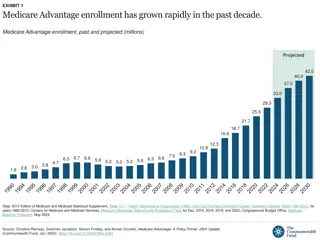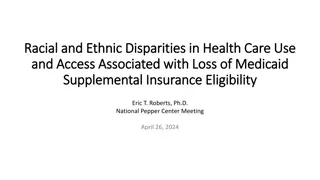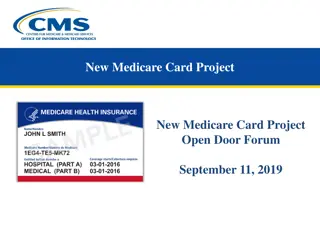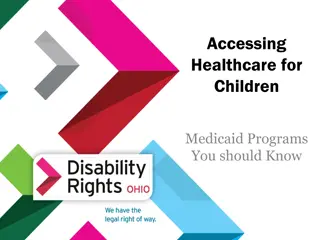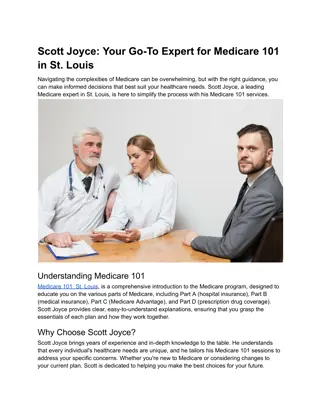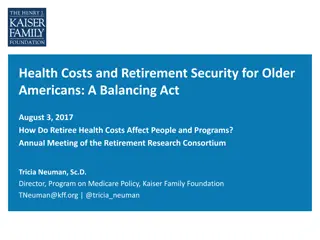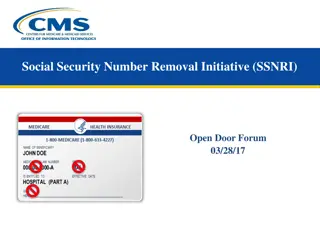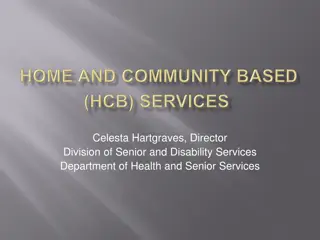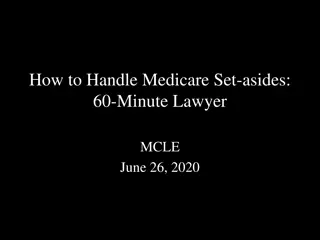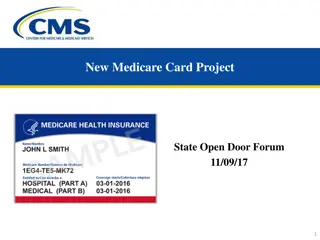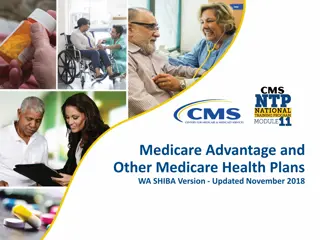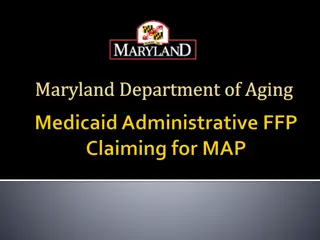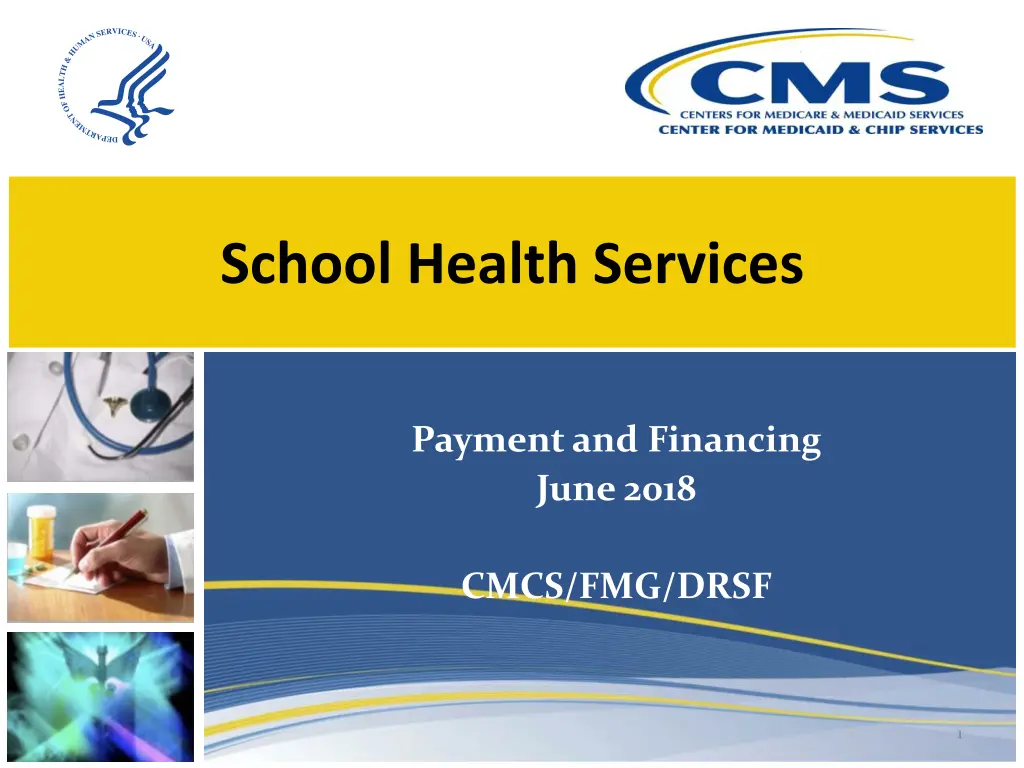
Understanding Medicaid Reimbursement for School Health Services
Explore how Medicaid services in school settings can be reimbursed, learn about Free Care policy, payment basics, and funding options, along with important Medicaid rules for school-based providers. Discover the range of services covered and Medicaid eligibility criteria in schools.
Download Presentation

Please find below an Image/Link to download the presentation.
The content on the website is provided AS IS for your information and personal use only. It may not be sold, licensed, or shared on other websites without obtaining consent from the author. If you encounter any issues during the download, it is possible that the publisher has removed the file from their server.
You are allowed to download the files provided on this website for personal or commercial use, subject to the condition that they are used lawfully. All files are the property of their respective owners.
The content on the website is provided AS IS for your information and personal use only. It may not be sold, licensed, or shared on other websites without obtaining consent from the author.
E N D
Presentation Transcript
School Health Services Payment and Financing June 2018 CMCS/FMG/DRSF 1
Session Objectives Understand how Medicaid services provided in the school setting by school providers, school health centers, and other providers can be reimbursed Understand the basics of the Free Care policy Understand payment basics Fee For Service (FFS) Understand funding basics Special topic - telehealth basics 2
Medicaid Rules There is no service category in Medicaid entitled school-based services, or early intervention services, or Individualized Education Program (IEP) services To be eligible for payment by Medicaid, services must be included among those listed in Title XIX, section 1905(a) of the Social Security Act Services must be coverable in the state plan which makes services available to children 0-21 available to all beneficiaries under EPSDT Health services covered by Medicaid and provided in schools must be defined in terms of Medicaid s statutory and regulatory requirements 3
Medicaid Rules All prescribing, ordering and referring providers are required to be enrolled with the Medicaid program. Specifically, physicians and other professionals recognized by the State Medicaid agency as providers are required to have a provider agreement and a Medicaid provider identification number. For school-based providers, the enrollment requirements for prescribing, ordering and referring apply. Specifically, school-based providers are subject to the ordering and referring requirements set forth in 1866(j)(2) of the Social Security Act (the Act) and 42 CFR 455.410 and 455.440. 4
Services Provided in Schools Medicaid services are not limited to those included in an Individualized Education Plan (IEP) or Individualized Family Service Plan (IFSP.) May also include: other health care services under section 1905(a) of the Social Security Act provided by qualified providers enrolled in the Medicaid program to Medicaid eligible individuals. Medicaid-covered health care services included in a child s individual service plan per section 504 of the Rehabilitation Act of 1973. Tip: If a state seeks to amend its state plan to expand Medicaid covered services in schools beyond what is included in an IEP or IFSP, Medicaid services must be available to Medicaid eligible individuals who meet the medical necessity criteria for the services. 5
Medicaid Coverage A service can be covered by Medicaid when: Rendering providers must meet provider screening requirements and claims must include the NPI of the physician or other professional who ordered or referred such items or services. (42 CFR 455.400 455.470) Rendering providers must meet qualifications as required under the state plan Services must meet requirements for coverage under the state plan Individuals are able to choose to receive Medicaid services from a pool of qualified practitioners which may include those in schools and other community locations Not covered by Medicaid are activities performed solely to meet IDEA requirements such as scheduling IEP/IFSP meetings, development and writing of the IEP/IFSP, & providing notice to IEP/IFSP team members 6
Free Care Guidance Pursuant to a State Medicaid Director Letter (SMDL) issued on December 15, 2014 (14-006), Federal Financial Participation (FFP) is available in expenditures for covered services provided to Medicaid beneficiaries as long as all Medicaid requirements are met, regardless of whether the service is otherwise available without charge to the beneficiary 7
Policy on Payment for School Services Because schools are public providers of primarily non-medical services and because, in general, third party payers other than Medicaid do not reimburse for services provided in the schools, Medicaid requires that states demonstrate that rates paid for services in schools are no higher than the actual cost of providing the medical services 8
Policy on Payment for School Services A state may pay providers the Medicare rate without demonstrating cost CMS s policy on the rate helps to assure that payment meets the requirements of section 1902(a)(30)(A) which specifies that payment be economic and efficient 9
Funding the Non Federal Share Total computable (TC) state Medicaid expenditure: the amount a state expends for the rendering of a Medicaid service Federal financial participation (FFP): The funding provided by CMS as its share of the TC state Medicaid expenditure Federal Medical Assistance Percentage (FMAP): The % at which CMS provides FFP as its share of the TC state Medicaid expenditure 10
Funding the Non Federal Share Basic References 42 CFR 433.51 Local govt. participation in funding 42 CFR 433.56 Classes of health care services and providers defined 1905(b) of the Social Security Act specifies FMAP for states 1902(a)(2) of the Social Security Act requires that reimbursement not be contingent on funding 11
Sources of the Non Federal Share General fund revenue appropriations to the Medicaid agency Permissible taxes and provider donations Intergovernmental Transfers (IGT) Certified Public Expenditures (CPE) 12
Funding Mechanisms CPEs Must be actual cost Annual reconciliation (identifying the difference between any interim payments and cost) is required In the case of certain payments which exceeds cost, the State must settle to cost. Cost settlement cannot occur as an adjustment to future rates IGTs or Appropriations Community rates can be used No reconciliation required Current policy IGT must be made prior to payment by the Medicaid Agency. Provider must retain the entire payment 13
Certified Public Expenditures A CPE is an expenditure made by another unit of government on behalf of the single State Medicaid Agency A governmental provider may certify its actual incurred cost. Additionally, a unit of government that reimburses a non-governmental provider a rate may certify the cost of the rate When a governmental agency is itself the provider then it may not certify the cost of a rate that it pays to itself 14
CPE Cost Principles In reporting cost providers must adhere to 45 CFR 75 Uniform Administrative Requirements, Cost Principles, and Audit Requirements for HHS and 42 CFR 413 Principles of Reasonable Cost Reimbursement Providers must allocate cost using a CMS approved cost report and time study 15
Cost Reporting Cost must be reported annually by the LEAs to the Medicaid agency using a CMS- approved SBS cost report and a CMS- approved Random Moment Time Study for direct medical services 16
Direct Cost Direct costs include salaries and fringes of direct medical personnel, direct medical supplies and equipment, and costs related to contractors providing services CMS requests states to complete a chart which specifies the types of practitioners it proposes to include in the direct services cost pool Permits States to document that these providers are Medicaid qualified 17
Personnel Cost and Time Studies Personnel costs are allocated to direct service costs using a CMS-approved time study. These costs are further adjusted by the ratio of Medicaid children with IEPs to total children with IEPs The time study and codes and allocation statistic would be modified when certified cost covers services provided through free care 18
CPEs and Billing Although cost is identified in the aggregate when CPEs are used, without respect to the number of claims submitted, states are still required to record claims for SBS in the MMIS MMIS provides for prompt eligibility verification and a complete audit trail from service to claim 19
Medicaid Administrative Claiming Principles An allowable administrative cost may not include overhead costs of operating a facility An allowable administrative cost may not include the operating costs of an agency whose primary purpose is other than operation of the Medicaid program An allowable administrative cost must be included in a CAP approved by HHS Cost Allocation Services 20
Medicaid Administrative Claiming Principles An allowable administrative cost must be directly related to a Medicaid state plan or waiver service An allowable administrative cost cannot reflect the cost of providing a direct medical or remedial service An allowable administrative cost cannot be an integral part or extension of a direct medical or remedial service, such as patient follow-up, patient education, and counseling 21
Examples of School Medicaid Administrative Activities Medicaid Outreach Facilitating Medicaid Eligibility Determinations Translation Related to Medicaid Services Program Planning, Policy Development, and Interagency Coordination for Medical Services Referral, Coordination, and Monitoring of Medicaid Services 22
Telehealth Telehealth is an alternative approach of providing 1905(a) services used to facilitate the provision of services Does not replace any covered services No Medicaid rules on Telehealth, allows states flexibility in designing Telehealth offers two-way, real time interactive communication that links a patient at an originating site and a provider at a distant site States have the flexibility to set program parameters defining when & how services may be provided using telehealth
The School as an Originating Site Usually, a school would serve as an originating site, where students would receive services The originating site can certify the additional cost associated with telehealth services but cannot include start-up costs in the certification Originating sites must follow state s parameters for delivery of services through telehealth 24
Sample Telehealth Criteria Participant is eligible to receive telehealth services if the individual: Enrolled in Medicaid on the date the service is rendered Consents to telehealth services (unless there is an emergency that prevents obtaining consent) Present at the originating site at the time the telehealth service is rendered Authorized to receive services, except for services provided in a hospital emergency department
Potential Originating Sites College or university student health or counseling office Community-based substance use disorder provider Deaf or hard of hearing participant s home or any other secure location as approved by the participant and the provider Elementary, middle, high, or technical school with a supported nursing, counseling or medical office Local health department; Federally Qualified Health Center (FQHC) Hospital, including the emergency department Nursing facility Private office (physician, physician assistant, psychiatric nurse practitioner, nurse practitioner, or nurse midwife) Opioid treatment program Outpatient mental health center (OMHC) Renal dialysis center Residential crisis services site
Potential Distant Sites and Qualified Providers Potential Sites: Community-based substance use disorder provider Opioid treatment program Outpatient mental health center Federally Qualified Health Center (FQHC) Qualified Providers: Nurse midwife Nurse practitioner Psychiatric nurse practitioner Physician Physician assistant Provider fluent in American Sign Language providing telehealth services to a deaf or hard of hearing participant
Resources 12/15/2014 State Medicaid Director letter on Medicaid services provided without charge: https://www.medicaid.gov/federal-policy- guidance/downloads/smd-medicaid-payment- for-services-provided-without-charge-free- care.pdf 5/21/1999 State Medicaid Director Letter on current transportation policy: https://www.medicaid.gov/Federal-Policy- Guidance/downloads/SMD052199.pdf 28


